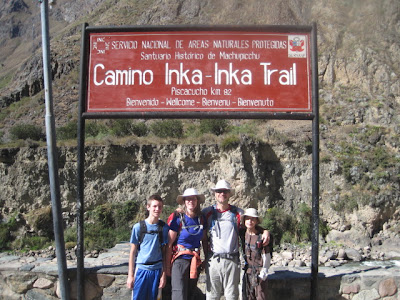 The Incan city of Machupicchu was built in the mid 15th century. The Incan Pachakutek designed it but would not have lived to see its completion. Given the number of enclosures to house families, it is thought that 500 people lived here at a time. In the dwelling and other buildings the stones were made to fit together to allow for settling. Most of the structures are in perfect condition except for the fact that the roofs, which were made from wood beams and thatching, are missing. Archeologists have restructured roofs on some of the dwellings to show how they think they may have looked originally.
The Incan city of Machupicchu was built in the mid 15th century. The Incan Pachakutek designed it but would not have lived to see its completion. Given the number of enclosures to house families, it is thought that 500 people lived here at a time. In the dwelling and other buildings the stones were made to fit together to allow for settling. Most of the structures are in perfect condition except for the fact that the roofs, which were made from wood beams and thatching, are missing. Archeologists have restructured roofs on some of the dwellings to show how they think they may have looked originally.
The Temple of the Sun, identified by its rounded exterior wall still houses an altar used for sacrifice. If you look out the windows of the temple you can view across to different parts of the city. Under the temple is another smaller temple dedicated to Pachamama, or Mother Earth. It is built amongst a natural upthrusting of gargantuan rocks. Although we were not allowed inside, there is evidence that it was used for ceremonial purposes.

 The city is in excellent condition, with very little damage from settling and earthquakes. On the left was one of the few walls that we could see damage by such things, not bad for 500 years. There is minimal damage due to erosion and this is attributed to the extraordinary canal system built throughout the entire city.
The city is in excellent condition, with very little damage from settling and earthquakes. On the left was one of the few walls that we could see damage by such things, not bad for 500 years. There is minimal damage due to erosion and this is attributed to the extraordinary canal system built throughout the entire city.  I was very impressed with the expansive nature of the site. It was much larger than I had thought when I have watched television specials about Machupicchu. Some of the bricks used at the base of the walls are enormous. I wondered how they could move them and shape them to fit exactly to the next stone. The quarry from whence the rocks were hewn was inside the boundaries. Structures and terraces were built both above and below the quarry.
I was very impressed with the expansive nature of the site. It was much larger than I had thought when I have watched television specials about Machupicchu. Some of the bricks used at the base of the walls are enormous. I wondered how they could move them and shape them to fit exactly to the next stone. The quarry from whence the rocks were hewn was inside the boundaries. Structures and terraces were built both above and below the quarry. 
The rain did not let up as we toured the city. We discovered that our waterproof jackets weren't. We were tired, for we had been up since 4:00. We were hungry, for we hadn't eaten since 4:30. We were cold, for our clothes were soaked and the clouds shielded the sun's warmth. Although I had anticipated experiencing Machupicchu for many years plus four long days, I needed to leave Machupicchu, and soon. I could have explored for hours, but with three hungry boys grouching in my ear, I resigned myself to the fact that I will have to see Machupicchu in its entirety another day. Next time, by train.



















































